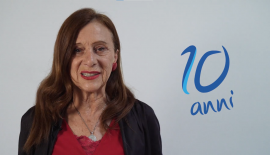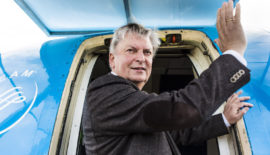Degenerate Art Artists – Entartete Kunst
Alexei von Javlensky (1864 – 1941)
Alexei von Javlensky is born on March 13, 1864, in Torzhok, Russia. In 1889, Javlensky gives up an established career in the Russian Imperial Guard to study painting under the Russian historical painter Ilya Repin. In 1896, disenchanted with realism, he moves to Munich, where he meets the painter Wassily Kandinsky, who will remain a lifelong influence. In 1905, he works with the Fauvist painter Henri Matisse, whose flat areas of vibrant color exert a further influence on his work. After returning to Munich, he spends several summers in Murnau with Kandinsky, Gabriele Münter, and Marianne von Werefkin, a Russian painter with whom Javlensky had arrived in Germany. In 1917, he starts on his well-known series of Mystic Heads and the following year Abstract Heads, which combines Fauvist and Expressionist notes with the tradition and spirituality of Russian art. Javlensky’s work is characterized by Expressionism, Symbolism, and Mysticism. During the Nazi regime, Javlensky’s art is considered “degenerate” because it does not conform to the Nazi’s ideal of art. In 1937, 72 of Javlensky’s works are confiscated, and two of these are displayed as part of their Die Ausstellung ‘Entartete Kunst’ (Degenerate Art) exhibition in Munich. Despite the Nazi regime’s efforts to discredit Javlensky’s work, his art continues to be exhibited in various museums and galleries around the world.
Der Blaue Reiter (The Blue Rider)
The philosophy behind the Der Blaue Reiter movement is to create a new wave of modern art that is different from the conventional and conformist art of its predecessors. The group is a loose association of artists with diverse aesthetic approaches, united by a belief in the spiritual power of colour. They aim to show, through the variety of forms represented, how the inner desires of the artist are embodied. The members of the group share the same ideas of creating art as a connection to the spiritual through the use of colour. They are interested in creating art that expresses emotions rather than depicting literal scenes. The group sought to transcend the mundane by pursuing the spiritual value of art. The artists associated with Der Blaue Reiter are important pioneers of 20th-century modern art, paving the way for Gorky, Pollock, Basquiat and their many artistic heirs today. The movement begins with a group of German artists in 1905. The name Der Blaue Reiter is widely believed to derive from a 1903 Symbolist canvas by Kandinsky. The group’s emblem is the Roman Christian soldier Saint George, who killed a dragon demanding human sacrifices.
Emil Nolde (1867 – 1956)
The son of Schleswig farmers, Emil Nolde began his artistic life with ornamental sculpture. He studied drawing at the Academy of Fine Arts in Karlsruhe and later at the Academy in Berlin. From 1884 to 1891 Nolde lived in Flensburg, where he worked in a furniture factory and studied to become a carver and illustrator. From 1892 to 1897 he taught ornamental drawing at the Industrial Art School in St. Gallen, Switzerland. From 1892 to 1897 he taught ornamental drawing at the School of Industrial Art in St. Gallen, Switzerland. In 1902, he discovered the paintings of Vincent van Gogh and Paul Gauguin during exhibitions in Berlin and Weimar, works that would profoundly influence him. His first known canvas, painted in Switzerland, dates back to 1895-1896 (Mountain Giants). In 1905 he moved to Berlin and met the painter Edvard Munch in 1907. He joined the Berlin Secession, but stayed there for a short period to create the Die Brücke movement with friends. During this period Nolde’s artistic style moved closer and closer to religious subjects, of particular creativity is a nine-part altarpiece on the life of Christ. On his travels to Siberia, the Pacific and Japan he experimented with watercolour painting and then returned to floral painting. In 1934 he joined the Nazi party. Goebbels appreciated his art and bought some of his paintings. A room was dedicated to Nolde in the National Gallery in Berlin. But not all Nazi hierarchs appreciate him, for example Alfred Rosenberg does not appreciate his art and Adolf Hitler does not approve of his art either.. Nolde was therefore expelled from the Academy of Arts. During the campaign against ‘Degenerate Art’, most of his works – some 1,052 exhibited in German museums – were confiscated and some were destroyed on the orders of the Nazi-types. The regime prevented Nolde from painting and forbade him from buying painting materials. Despite this, with the secret help of his friends, he secretly produced a series of paintings in a calmer, more relaxed style.
Ernst Ludwig Kirchner (1880-1938)
He was a German painter, printmaker and sculptor, best known as one of the founders of the Die Brücke art group. Kirchner was born in 1880 in Aschaffenburg. He studied architecture in Dresden from 1901 to 1905, but abandoned his studies to devote himself to painting. In 1905 Kirchner and three other artists founded the art group Die Brücke. The group set out to create a new and modern art, in contrast to the artists’ establishment of the time, with the aim of gaining freedom of action in art and life. In 1911 Kirchner moved to Berlin, where he continued to paint and exhibit. In 1913, however, he suffered a nervous breakdown and was forced to suspend his artistic activities for a short time. Kirchner developed a painting style characterised by vivid colours and strong lines, reflecting the influence of German Renaissance art while updating it with the European avant-garde experience of Expressionism. After the First World War, Kirchner moved to Switzerland, where he continued to paint and exhibit. In 1937, however, his works were included in the ‘Degenerate Art’ exhibition organised by the Nazi regime, which condemned modern art as degenerate. The Nazis condemned more than 600 of Kirchner’s works to destruction. Unable to overcome his grief, the artist committed suicide in Davos, Switzerland, in 1938. Kirchner is considered one of the most important German artists of the 20th century, and his influence on painting and art in general is still felt today. His works have been shown in numerous exhibitions around the world and many are in important museums and private collections.
Franz Marc (1880-1916)
German painter, printmaker. Marc is considered one of the most important artists of the 20th century and one of the most prominent representatives of German Expressionism. Franz was the son of the famous painter Wilhelm Marc. In 1900 he enrolled at the Academy of Fine Arts in Munich to study painting and sports. He often travelled to Munich, Indersdorf and Kochel, as well as abroad, but some of his journeys had a strong influence on his artistic life, two of the most important for the artist were to Paris in 1903 and 1907. He devoted himself to studying the work of Vincent van Gogh and painted mainly landscapes and portraits during these years. To support himself, he illustrated books and gave private lessons. In 1910 Marc joined the Munich Expressionist group ‘Neue Künstlervereinigung’, a precursor of ‘Der Blaue Reiter’, and actively participated in all the exhibitions of this new painting movement. In 1913 he exhibited at the ‘First German Autumn Salon’ at the Berlin gallery ‘Der Sturm’ and was very successful. The intense mysticism in Marc’s works, expressed in shapes and colours, made the artist famous and his works were sought after by the most important galleries. At the outbreak of the First World War, Marc enlisted in the German army and was sent to the Western Front. He died in Braquis on 4 March 1926 while on a war mission in France.Despite the artist’s death, the Nazi regime purged museums of his works, declaring them to be degenerate, and from the first exhibition in 1937 they were exhibited in the Entartete Kunst (Degenerate Art).
Wassily Vasilyevich Kandinsky (1866-1944)
Wassily Vasilyevich Kandinsky is was born on December 16, 1866, in Moscow. Kandinsky spends his childhood in Odesa, where he graduates from Odesa Art School. In 1886, he enrolls at the University of Moscow, where he studies law and economics. However, at the age of 30, he begins to study painting, including life drawing, sketching, and anatomy. In 1896, Kandinsky settles in Munich, studying first at Anton Ažbe’s public school and then at the Academy of Fine Arts. Music and spirituality converge in Kandinsky’s art. Due to his appreciation of the music of his time and his kinesthetic nature, Kandinsky’s works show a marked expressionist style in his early years. But in the course of his career, he embraces all the artistic styles of his time and of his predecessors. His visual vocabulary develops through three phases, moving from early representational canvases and their divine symbolism to lyrical and ecstatic compositions, and finally to geometric and biomorphic planes of color. Kandinsky founds the influential Munich group Der Blaue Reiter (‘The Blue Rider’; 1911-14) and begins a completely abstract painting style. He is considered one of the first creators of pure abstraction in modern painting. It is important to note that Kandinsky’s impulse to eliminate the subject matter altogether is not solely due to strictly aesthetic considerations. Indeed, Kandinsky seems to be unable to enjoy the physical properties of oil and pigment without worrying about their significance. The Degenerate Art Exhibition “Entartete Kunst” of 1937 features some 50 of Kandinsky’s works. They are later sold at auction to foreign buyers.
Lasar Segall (1889-1957)
He was a Lithuanian-Brazilian Jewish painter, printmaker and sculptor. Lasar Segall was born in Vilnius, Lithuania, the son of a Torah scribe. Segall’s art derives from Impressionism, Expressionism and Modernism. His most significant themes are depictions of human suffering, war, persecution and prostitution. Segall moved to Berlin at the age of 15 and studied first at the Königliche Akademie der Künste in Berlin from 1906 to 1910 and at the end of 1910 he moved to Dresden to continue his studies at the Kunstakademie Dresden as a ‘Meisterschüler. Segall published his first art book of five etchings in Dresden, Sovenirs of Vilna in 1919, and two illustrated books with lithographs entitled Bubu and die Sanfte. The artist then began to express himself more freely and develop his own style, incorporating aspects of Cubism while exploring his Jewish background. His early paintings, between 1910 and the early 1920s, depicted restless figures surrounded by exaggerated and bold strokes, influenced by African tribal figures. By 1912, Segall’s works largely depicted the masses of persecuted humanity in its expressionist form. He moved to São Paulo, Brazil, where three of his brothers were already living, and returned to Dresden in 1914, still very much in the Expressionist style. In 1919 Segall founded the ‘Dresdner Sezession Gruppe 1919’ with Otto Dix, Conrad Felixmüller, Otto Lange and other artists. Segall’s exhibition at the Galery Gurlitt received numerous awards. Although Segall was very successful in Europe, he was or strongly influenced by his time in Brazil, which had already transformed both his style and his subjects. The life he spent in Brazil gave Segall the opportunity to gain an insight into South American art. Upon returning to Brazil, Segall obtained Brazilian citizenship in 1923. During his stay in Brazil, his art was strongly influenced by the red light district of Rio de Janeiro. Many Brazilian artists influenced Segall’s subjects and reinforced his cubist form. The artist settled in his new country and painted themes that contributed to the Brazilian countryside, mulattos, favelas, prostitutes and plantations. Due to the harsh and extreme nature of Segall’s portrayal of prostitutes and his depiction of human suffering, his works create some problems and discussions Although Segall intended to reside exclusively in Brazil, he continued to travel back and forth to Europe for his solo exhibitions. In 1937, his works are also at the mercy of Nazi persecution, and his name is in the catalogue of the exhibition ENTARTE KUNST – Degenerate Art. Away from Germany, he managed to save himself from any persecution of the Jews of Europe. In Brazil he managed to achieve a very important role in art, as well as saving himself far from the Nazi regime.
Marc Chagall (1887-1985)
Born into a family of Jewish culture and religion, the son of a merchant, he is the eldest of nine siblings. In his works, the artist often recalls his childhood period in the shtetl, a Jewish village, as happy despite the sad conditions of Russian Jews under the Tsarist regime. From 1906 to 1909 he studied painting, first in Vitebsk, then at the School of the Imperial Society for the Defence of Fine Arts in Petersburg, where he was also a pupil of Léon Bakst. In 1910, Chagall moved to Paris. In the French capital he became acquainted with the new art movements of the time. In particular, he was drawn to Fauvism and Cubism. The approach of the start of the World War made Marc Chagall return to Vitebsk. In his hometown Chagall founded the Art Institute, of which he was director until 1920. He then moved to Moscow, where he created the decorations for the Jewish State Theatre ‘Kamerny’. In 1917, he took an active part in the Russian Revolution, so much so that the Soviet Minister of Culture appointed Chagall Commissioner of Art in the Vitebsk region. However, he was not successful in politics. In 1923, he moved to Germany, to Berlin, and finally returned to Paris. During this period, he published his memoirs in Yiddish, initially written in Russian and later translated into French. The painter also wrote articles and poems published in various magazines and collections – posthumously – in book form. In Paris, he reconnected with the cultural world he had left behind and met Ambroise Vollard, who commissioned him to illustrate several books. Thereafter, the artist travelled extensively, in Europe but also in what was then Palestine. While the rise of Nazism was taking place in Europe, all of Marc Chagall’s works in Germany were confiscated by the regime and considered degenerate art. Many of his paintings were to be found on the Entartete Kunst list since the very first exhibition in 1937. The intervention of art collectors saved many of his works, which would otherwise have been destroyed. For example, the Fischer Gallery in Lucerne intervened in 1939 and saved many of his paintings.
Gabriele Münter (1877-1962)
Gabriele Münter is born on February 19, 1877, in Berlin. She comes from a wealthy family that has lived in the United States for a long time. In 1901, Münter enrolls in an art course in Munich. She is a companion of Wassily Kandinsky, and together they found Der Blaue Reiter group. Münter’s work transitions from copying nature more or less impressionistically to feeling its content, abstracting, and drawing out an extract. She grows an interest in painting the spirit of modern civilization, its social and political turmoil, and its gravitation towards materialism and alienation. Münter notes that pictures are all moments of life: instantaneous visual experiences, generally rapid and spontaneous. Despite being raised in a family and country that discourages women from a career in the arts, Münter eventually becomes a prominent artist. Her work is exhibited in various museums and galleries around the world. Münter dies on May 19, 1962, in Murnau, Germany
Otto Dix (1891-1969)
German painter and printmaker, leading figure of the Neue Sachlichkeit movement. Born into a family of modest means, it was his parents who encouraged their son to devote himself to art. Otto Dix attended the School of Arts and Crafts in Gera and later the Academy of Fine Arts in Dresden. He served in the German army during the First World War and was deeply shocked by the horrors of war, which would influence his artistic style throughout his life. In fact, Dix’s work seems to portray the traumas he experienced on canvas through a harsh and realistic depiction of German society during the Weimar Republic and the brutality of war. Among his most famous works are ‘The War’ (1924), a series of 50 etchings depicting the horrors of war, and ‘Portrait of the Journalist Sylvia von Harden’ (1926), a satirical portrait of a Berlin journalist. After the war, he studied at the Hochschule für Bildende Künste and became a founding member of the Dresden Secession. His work is distinctly Expressionist, influenced by George Grosz and Dadaism, but in the 1920s Dix’s art began to take on more realistic and despairing features, as evidenced by his painting ‘The Trench’, which depicts decomposed and dismembered soldiers. During the Nazi regime, Dix was considered a degenerate artist and his works were banned, removed from museum collections and exhibited since the first Entartete Kunst (Degenerate Art) exhibition in 1937. As a result of the Nazis, he lost his teaching post at the Academy of Fine Arts in Dresden and was forced to move to Lake Constance, where he concentrated on religious and landscape painting. During the Second World War, Dix was conscripted and taken prisoner by French troops, but was released in 1946. Serving in another war further traumatised the artist and this was reflected in his work. He died in 1969 in Singen, Germany. Dix’s legacy continues to influence contemporary art and his work can be found in major museums and galleries around the world.
Paul Klee (1879- 1940)
Paul Klee is born on 18 December 1879 in Münchenbuchsee, near Berne. The son of musicians, he starts studying the violin at the age of seven. A few months after his birth, the family moves to Berne, where his father teaches at the Hofwyl Conservatory. Paul grows up in a cultured environment, with a particular interest in poetry, music and painting. In 1898 Klee leaves for Munich and enrols at the Academy of Fine Arts, where he studies under Franz von Stuck. During this time he begins to write his diaries, which last until 1918. Klee works in relative isolation, experimenting with various styles and media, such as caricatures and symbolist drawings, and later producing small works on paper mainly in black and white. Until he returns to Munich in 1911, where he joins the German expressionist group Der Blaue Reiter (The Blue Rider), founded by Wassily Kandinsky and Franz Marc. Klee’s work is characterised by a poetic and imaginative approach to reality, which he achieves through a profound study of the magical relationships between forms, ideas and colours. He is an artist of intense spirituality who believes that the material world represents only one of the many windows open to human knowledge. His use of drawing, colour, traditional codes, ideographic, geometric and figurative signs transformed into innovative and meaningful ensembles, clearly shows his attempts to use art as an instrument of his philosophical conception. Klee’s artistic training benefits from other significant encounters, but it should not be forgotten that the originality of Paul Klee’s production is also due to his familiarity with music and his consequent mastery of the compositional process that paves the way for an aesthetic conception capable of assimilating and merging with the cultural and artistic humus of his time. Klee dies on 29 June 1940 in Muralto, Switzerland. During the Nazi regime, Paul Klee is stigmatised as a ‘degenerate’ artist and his work is included in the propaganda exhibition ‘Entartete Kunst’, which is opened in Munich in 1937.




